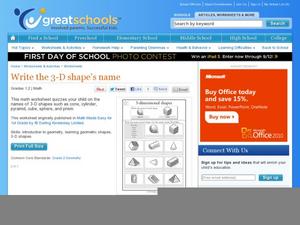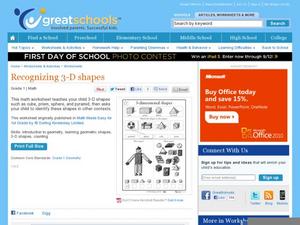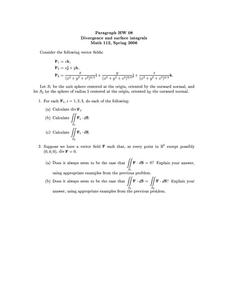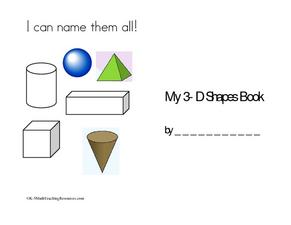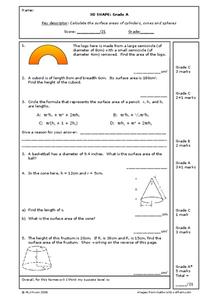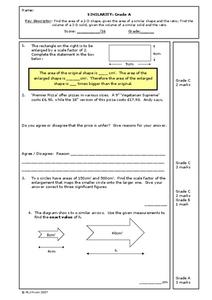Curated OER
Flower Vases
Which vase holds more water: a cylinder, sphere, or cone? Figure out which should be used for your sister's birthday bouquet with this practical word problem.
Curated OER
Write the 3-D Shape's Name, Part 2
Geometry can be fun when you know the shapes! Twelve pictures of geometric shapes, including cones, pyramids, and spheres, prompt first graders to write the name of each shape in the space provided. Use the activity as a quiz or homework...
Curated OER
Write the 3D Shape's Name
Can your first graders identify a cone? What about a cube? Or a prism? Help them find the differences between these shapes with this worksheet, which provides a word bank for three-dimensional shapes. For extra practice, bring in...
Curated OER
Recognizing 3D Shapes, Part 3
Do your first graders know the difference between cones and cylinders? Use this handy activity to help youngsters learn geometric shapes. With prisms, spheres, and pyramids, among others, this resource prompts pupils to identify each...
Curated OER
Recognizing 3-D Shapes, Part 2
Take your math lesson to another dimension with this lesson about 3-D shapes! First graders label cones, cylinders, pyramids, spheres, cubes, and prisms, and then count the number of each shape in a collective picture. A great way to...
Curated OER
Recognizing 3-Dimensional Shapes
Three-dimensional shapes are all around us; expose young geometers to this concept as they focus on identifying four figures: cube, prism, sphere, and pyramid. Learners begin by matching four objects to the shape each...
Curated OER
3-Dimensional Shapes
Where is the vertex? Each of these three-dimensional figures is drawn so learners can see all sides and corners. They examine an example before trying six on their own. Some of these will be tricky, so be sure kids have covered this...
Curated OER
Volume of Solids
For this volume of solids worksheet, tenth graders solve and complete 20 various types of problems. First, they write the formula needed to find the volume of each solid. Then, pupils use the Pythagorean theorem to find the measure of...
Curated OER
Living in a Geometrical World
Students participate in a series of hand-on, online, and multimedia activities to examine 2 dimensional and 3 dimensional shapes. They describe common geometric solids. They construct rectangular prisms using straws and ribbon.
Curated OER
Divergence and Surface Integrals
In this divergence and surface integrals worksheet, learners explore given vector fields and calculate the divergence and surface integrals of given functions. This one-page worksheet contains 5 multi-step problems.
Curated OER
Volume Worksheet I
In this volume worksheet, students recognize three-dimensional figures, identify the proper volume formula, and then solve the equation by inserting information from a diagram into the formula. Students solve six equations.
Curated OER
Volume of a Snow Cone
Learners find the volume of a snow cone. They divide the snow cone into known sections, and find the are of each part. Pupils must read the scale on the snow cone, prior to plugging into the formula for its volume.
Curated OER
Sorting 3-Dimensional Shapes
The sorting is simple here: Does this three-dimensional figure have a curved surface or not? Scholars review an example before trying this on their own with nine figures including a sphere, cylinder, prism, cube,...
Curated OER
Relative Position Step-by-Step Lesson
Kindergartners demonstrate their ability to describe the relative positions of two objects. The two problems at the top of the activity are followed by written and illustrated explanations of the meanings of inside and “outside.”
Curated OER
Understanding Categories of Shapes
What are these shapes? Scholars match seven shapes to their names: rhombus, sphere, square, cone, circle, triangle, and parallelogram. Although there isn't much to this worksheet, the shapes are nicely colored and it would...
Curated OER
Name the 3 Dimensional Shapes of the Objects
Here are six solid figures for learners to identify. The names are listed along the left side and the shapes pictured on the right. Each shape is shown as a familiar object instead of just a drawing. Figures include a cylinder,...
Curated OER
I Can Name Them All!
Six 3-D shapes are featured in this figure-recognition book template. As they create a "My 3-D Shapes Book," young scholars place shapes on the appropriate pages, which already have text indicating the shape and its color. Although it is...
Curated OER
Circles 1, 2, 3, 4
Here is a way to help your charges identify circles and spheres. In this shapes geometry and technology lesson, students identify and draw circles and explain the related attributes. They recognize circles and spheres while exploring...
Curated OER
Spheres Homework
In this spheres instructional activity, students determine the volume and area of spheres when given the diameter or radius. This one-page instructional activity contains 10 multi-step problems.
Curated OER
Earth's Rotation
Fourth graders investigate the Earth's rotation. In this Earth's rotation lesson, 4th graders realize that the rotation of Earth causes the days and nights on Earth. Students break into groups and use a flashlight and a sphere to...
Curated OER
3D Shapes
In this 3D shapes activity, 10th graders solve and complete 5 various types of problems. First, they find the area of the logo item shown. Then, students find the height of a cuboid given its length and width. In addition, they circle...
Curated OER
Similarity
In this similarity worksheet, 9th graders solve and complete 6 different types of problems. First, they complete the statement in the box shown. Then, students determine whether they agree or disagree with the statement and given...
Curated OER
Volume and Surface Area
In this volume and surface area activity, 10th graders solve and complete 12 different types of problems. First, they find the volume of an isosceles trapezoid. Then, students find the volume and total surface area of a sphere. They also...
Curated OER
Volume and Surface Area
In this volume and surface area worksheet, 10th graders solve and complete 12 different types of problems. First, they find the volume and total surface area of a given circle. Then, students find the height and radius of a cylinder...




